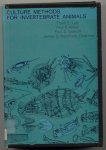SludgeMunkey
New member
- Joined
- Nov 11, 2008
- Messages
- 2,299
- Reaction score
- 101
- Points
- 0
- Location
- Bellevue, Nebraska
- Country
- United States
- Display Name
- Johnny O. Farnen
Culture Methods for Invertebrate Animals (out of print)
F. Lutz, P. Welcj, P. Galtstoff, J. Needham
(1959 Dover Books reprint of the 1937 Comstock Publishing Company Edition)
590 pages
Yes, it is old. Very old. The taxonomy used is so far out of date as to be comical. Why even bother to review this dusty old tome, often found under a moldering pile of well used paperbacks in the back of a used book store?
Very simply, this is still a valid source of data for the hobbyist. While designed with research scientists of the time, this makes the book all to useful to the budget pet keeper. The methods and procedures described were cutting edge in many cases. However they have since been overshadowed by modern technology. The advantage to the home hobbyist is that these "dated" methods still work and do not require the fancy equipment and chemicals that some modern techniques require. For under 20 dollars, you can construct all most any rearing method for about anything living you can think of to feed your pets.
The old standbys are here: Daphnia, Maggots, Cyclops, various worms...and more. Starting off with numerous Protozoa, this book works it's way up through TO Chordata, including ascidians. Here you will find such hard to find gems like how to breed medically sterile maggots, low budget fruit flies, and even the infamous "infosuria".
Almost all the equipment mentioned can be purchased cheaply or found around the house. Any chemicals involved are available in the grocery or health food shop. Instructions to manufacutre tanks, jars, and anything else you need are included.
This book is readily available used online for very cheap. It can even be found in PDF format for FREE!
I highly reccomend this book to any serious critter keeper, you will lean more than you ever needed about growing your own live foods.
F. Lutz, P. Welcj, P. Galtstoff, J. Needham
(1959 Dover Books reprint of the 1937 Comstock Publishing Company Edition)
590 pages
Yes, it is old. Very old. The taxonomy used is so far out of date as to be comical. Why even bother to review this dusty old tome, often found under a moldering pile of well used paperbacks in the back of a used book store?
Very simply, this is still a valid source of data for the hobbyist. While designed with research scientists of the time, this makes the book all to useful to the budget pet keeper. The methods and procedures described were cutting edge in many cases. However they have since been overshadowed by modern technology. The advantage to the home hobbyist is that these "dated" methods still work and do not require the fancy equipment and chemicals that some modern techniques require. For under 20 dollars, you can construct all most any rearing method for about anything living you can think of to feed your pets.
The old standbys are here: Daphnia, Maggots, Cyclops, various worms...and more. Starting off with numerous Protozoa, this book works it's way up through TO Chordata, including ascidians. Here you will find such hard to find gems like how to breed medically sterile maggots, low budget fruit flies, and even the infamous "infosuria".
Almost all the equipment mentioned can be purchased cheaply or found around the house. Any chemicals involved are available in the grocery or health food shop. Instructions to manufacutre tanks, jars, and anything else you need are included.
This book is readily available used online for very cheap. It can even be found in PDF format for FREE!
I highly reccomend this book to any serious critter keeper, you will lean more than you ever needed about growing your own live foods.

